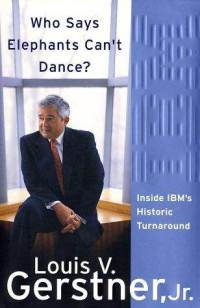Managing the Elephant
Many business books use the metaphor of an elephant to get their big points across.
 Louis Gerstner says in “Who Says Elephants Can’t Dance,” that elephants can dance. Lou’s story of his involvement in the turnaround and saving of IBM is a fascinating read for anyone in business. He talks about leading, culture, vision (yeah, vision), focus, execution, team building, creating a nimble, responsive large organization and how to pick up the pieces when everyone around you thinks that is a fool’s errand. His elephant is big and if tamed, had a size that could be leveraged. It had a breadth and depth that allowed for greater investment, greater risk taking and longer patience for future payoff. He said that it isn’t a question of whether elephants can dance, but whether a particular elephant can dance – and if so, then everyone else must leave the dance floor. Gerstner claims as essential the issue of centralization vs. decentralization in large enterprises and he offers his analysis of the pros and cons of both. He also offers his advice of how to deal with each. His specific examples can be adapted by any size organization with at least two divisions – and he includes not-for-profit and government organizations in his discussion Gerstner raises an interesting issue – measuring and compensating the future rather than the past. I think this needs thought by many companies using past success as basis for determining bonuses.
Louis Gerstner says in “Who Says Elephants Can’t Dance,” that elephants can dance. Lou’s story of his involvement in the turnaround and saving of IBM is a fascinating read for anyone in business. He talks about leading, culture, vision (yeah, vision), focus, execution, team building, creating a nimble, responsive large organization and how to pick up the pieces when everyone around you thinks that is a fool’s errand. His elephant is big and if tamed, had a size that could be leveraged. It had a breadth and depth that allowed for greater investment, greater risk taking and longer patience for future payoff. He said that it isn’t a question of whether elephants can dance, but whether a particular elephant can dance – and if so, then everyone else must leave the dance floor. Gerstner claims as essential the issue of centralization vs. decentralization in large enterprises and he offers his analysis of the pros and cons of both. He also offers his advice of how to deal with each. His specific examples can be adapted by any size organization with at least two divisions – and he includes not-for-profit and government organizations in his discussion Gerstner raises an interesting issue – measuring and compensating the future rather than the past. I think this needs thought by many companies using past success as basis for determining bonuses.
“The Elephant in the Room” by Ed Baker is a financial planning story on how to focus on the big picture goals that reflect your values and need discipline to stick to the plan – rather than the details and maneuvers that are less structured, easier to do, but actually are out of your control. “The Elephant in the Room” is also an old expression for something obvious that is ignored. Elephants are impossible to overlook, so people disregarding them are probably being foolish or obstinate.
“Juggling Elephants” by James Loflin and Todd Musig tells about people with a “too much to do” to do list. Too many things needing to get done, people to see, priorities to meet, and too little available time. It takes a circus ringmaster to set the author straight after it is explained that trying to get everything (or too much) done is like juggling elephants – it won’t happen.
“Bag the Elephant” by Steve Kaplan tells how to win – and keep – really big customers.
A version of “The Emperor’s New Clothes” depicts the Emperor as a big, proud, vain (and stupid) elephant.
Using elephants makes it easy to describe big people, events, ideas and things. Maybe it’s time for leaders to concentrate more on the elephant and let their managers and supervisors handle the details.
P.S.. All these books are worth reading.
How Can We Help?



